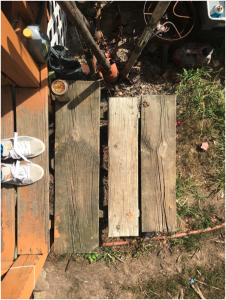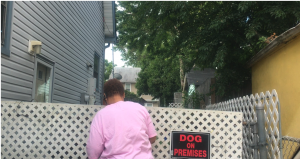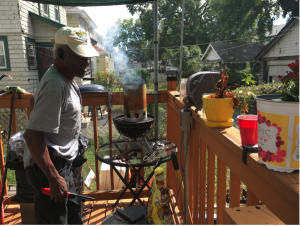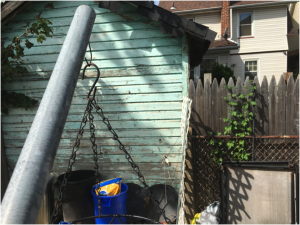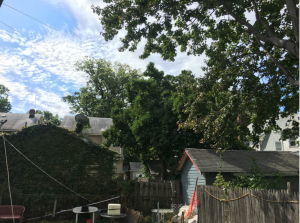My interests fall, essentially, on the other end of the spectrum with regards to this documentary class. I am a mechanical engineering major, with a possible minor in computer science. I do well in the math and sciences, while I often struggle in humanities classes. When I see machines, structures, and tools, I am intrigued. I want to know how they work and how they were made. I like to understand its makeup, components, and how they all work together. As an engineering major, I am a problem solver, learning how to think a certain way. When I come across different issues I like to listen to all possible ideas and analyze which will give the best solution. Usually that leads to questioning why and how in order to better understand and make the best decisions. If I were to use documentary, I would look into innovation: What is being created? and How is it being done? I think I would tell a story right here at my second home, Lehigh University, where I could get a look firsthand and maybe even follow the progress of the project. There might even be potential for me to be a part of the project, and that would make for an even better story.
Monthly Archives: September 2017
Reflection on 9/4’s class
Last class definitely felt like a game show challenge. We were tasked on the spot to create a 60-90 seconds documentary with a group of people we didn’t know. I didn’t think the project would be super difficult, until five minutes in and my group’s microphones weren’t working. While we worked on that, we hit the ground running in terms of brainstorming ideas. At first, we all agreed to do a story on pets, but Andrea then suggested we try to do a politics story, specifically on DACA. It was cool seeing how fast we set up the equipment and our setting (the studio), and how we all pitched and revised ideas for how we would tell our story. We each had different strengths (coming up with ideas, using the cameras/microphones, editing, etc) but in the process of quickly finishing our doc, we challenged each other to be involved with the steps and learn from each other. Overall, I think our group worked extremely well together and was able to produce a piece we were proud of, given the time constraints. I think the final pieces of other groups also reflected their hardwork and creativity, especially the different approaches to the pets topic.
Walking Around with a Frame
As I began walking from Lehigh’s campus down towards 4th Street with a flimsy cardboard frame in hand an overwhelming feeling came over me that I had not anticipated. When I had previously thought about what I might feel or experience when I set out to perform this experiment, I had imagined that I would see the world in completely different light. I imagined deeper greens in leaves, a bluer sky, and a rediscovery of the beauty of our world. I expected brief a rush of feelings of gratefulness and love. However, when I made my first left onto the busy streets of South Bethlehem and held my frame in front of my face all I could pay attention to was the judging eyes of others around me. I felt insecure. I realized how odd I had looked.
As one might assume, my highly romantic expectations about how I might after completing this assignment were not really met. From a visually standpoint, everything looked relatively the same. The only discrepancy was the giant poorly constructed frame that obstructed my every view. However, despite my slight disappointment resulting from my poor assumptions, I still feel that I took a lot away from this assignment.
The frame did not change necessary magnify the beauty of what I saw, but it did change how I perceived my surroundings in two ways. Firstly, walking with the frame really called me to slow down and really notice the special qualities of my environment. It stopped to notice the diversity in the people in both class and race, I realized the details in the architecture of the buildings, and I took note of smells and sounds gave the environment new life. Secondly, doing this assignment gave me new opportunity and to reimagine the city in a new life. I could see every shot as a smaller part of a bigger fictional story. Joggers became secret agents in pursuit of stopping evil and statues outside of the Banana Factory became relics of the dead in a horror film. I feel that this experience caused me to think a bit about how prospective and information can really shape a story.
In hindsight, I realized that the people who stared at me were missing the larger picture. Walking around with a cardboard in front of my face was not all that was weird about this assignment. What was truly weird was that I was taking a moment to really take in and understand the scenes of everyday life in South Bethlehem. This is not something I do often enough.
Grizzly Man Reaction
Watching The Grizzly Man in class caused me to question some of the traditional ideas that I associate with documentaries. I often forget that all a documentary is, is an account of nonfictional events through film. I typically think about them as textbooks made into movies. That is, I view them as well researched compilations of knowledge by experts on a specific topic or in a specific field. The topics are usually either quite large or serve some biographical purpose. Many documentaries I’ve also aim to provide a historical account of some event. The Grizzly Man does not necessarily go against my ideas of what a documentary should but the film certainly does challenge them. The film centers on this goofy guy who spends a large portion of his life recording his experiences living amongst bears. The film seems to center on the questions of the man’s sanity and whether his work with the bears truly helped ensure their survival. The scenes, events, and organization greatly extend what I believe to be typical in documentary. This makes me excited to create these types of films and has opened my imagination to the frameworks of documentary.
Making A Film
My introduction into creating film came during my senior year of high school when some of my friends and I started a band. We shot a couple of cringey music videos for our cover songs and posted them YouTube hoping to gain a bit exposure. That project died the summer we all went away for college. Before high school ended, however, a smaller group of friends and I shot a short film for a school project. It lacked a formal script, the shots were over-exposed, and the acting was unintentionally comedic. But it was a story that someone could follow and understand without a lot of mental strain. We were proud of it.
It was not until last year that I started making films of my own. So far, I have only ventured into making documentaries. I’ve made films about interracial relationships and Greek culture at Lehigh University. I have also helped another student make a film about major choices. These projects all started off as questions that I needed to know the answers too. I was extremely passionate about getting to discuss a topic and using those discussions to inspire other people to think a little bit more about issues that aren’t always obvious.
I mention my previous film making experience in this post primarily because of how much those experiences differ from the one I had in class last Monday. Up until that lecture, all the projects I made were ignited by some self-initiated aspiration to learn and have fun. Every time I shot, I felt like I was journeying into a new adventure. In class, all I could focus on was getting the project done. Me nor my fellow group members seemed to really care much about the movie was about. We had a limited amount of time and just wanted something presentable.
I found this project to be mechanical. There was no love or passion in what I was doing. I had fun overall, but did not care about the work I was creating. I realized going forward that I only want to work on film projects that I really care about. The more positive side of what I gained from this experience was a sort of deconstruction of film as this a grandeur thing. I am beginning to see it more as tool to convey my thoughts and ideas to an audience.
Making #1 A story using stills
Framing the World
As I prepared to start the framing assignment, I made a plan. I would walk from the College’s library on Chew Street, pass the cemetery, and turn right on N 17th Street toward the Allentown Fair, and then once the 30 minutes finished, I would take the same path back to my dorm. I soon abandoned the plan and instead turned on to North St George Street because the smell of the Fair’s animals was too distracting. Sight wasn’t the only factor in how I was framing the world, and when I came to this conclusion, I was more willing to go with the flow and actually explore my surroundings. I saw couples walking together, kids playing on sidewalks and people sitting on their porches watching me watch them through a tiny frame. I saw lights: dim and flickering street lights, gold christmas lights, lights shining from TVs, neon lights from the fair’s amusement rides, and more. I thought of how I could use the light (for example, looking at the moon) or the artificial lights I saw to help establish what belonged in the frame. This led to the idea of being critical about how I decided to frame my sights. During the 30 minutes, I was hyper-aware of everything around me, but I had to question why I was framing the alley, for example, the way I was. Did it just look aesthetically pleasing, or was I making an analytical decision to frame my surroundings in whichever way? As Robert Coles mentions in his book Doing Documentary Work, our ‘location’, or who we are, informs what we see as worth noticing, documenting and ultimately sharing alongside other images. I also thought a lot abut how creating a frame is essentially setting boundaries on what we see, and that the boundaries we decide to set may and will be different from what someone else’s. Lastly, I considered how moving my frame even just an inch would shift the image inside of it and the relationship between details and the larger picture.
Academic Perspective and Subjectivity
I study Media and Communication and I’m minoring in Africana Studies. I approach issues or potential topics by thinking about the many stories that can and haven been told and how I could offer a new or nuanced perspective. I approach issues/topics/potential stories by doing research and using what I and to help compose the layers of whatever story I’m focusing on. I see the world as nuanced and if we study and highlight the nuances we see then we are able to understand ourselves a little more. I’m interested in exploring character (person, place, etc) driven stories that deal with identity or social justice, for example. If I were to tell a story about a place in the Lehigh Valley it would explore the Center City Thrift Shop in Allentown because it is seen by many to just be a thrift store, when in fact the store’s initiatives supports the only community wireless (wifi) network in the Lehigh Valley.
Documentarian
As a documentarian, I document what I see and feel is worth saving/sharing. I’m definitely a planner in some instances and enjoy the process of thinking about what I want to create, but I’ve learned that being spontaneous can yield unexpected+rewarding results. I try to remain aware of what/how I see things, and understand that this differs from other documentarians. I try to question myself about why I view the world in the the ways I do and why I decide to document and share it. I feel satisfied being able to be picky about what/how I want to document something.
Lehigh Valley Story
http://www.lehighvalleylive.com/news/index.ssf/2017/06/pennsylvania_toughens_animal_c.html
http://www.lehighvalleylive.com/lehigh-county/index.ssf/2017/05/spca_seizes_47_animals_from_un.html
I want to do my short documentary film on animal mistreatment in the Lehigh Valley. I have always been passionate about standing up for animals rights and it really shakes my core to hear about kill shelters and abused dogs, cats, and other animals. I noticed this passion develop when I heard about pit bulls potentially being banned from certain states and Canada. I feel this is an issue that doesn’t get enough notice and seriously needs to be brought to more people’s attention.
Working longline: A short documentary film on animal mistreatment and animal shelters in the Lehigh valley.
Working title: Bad to the Bone

